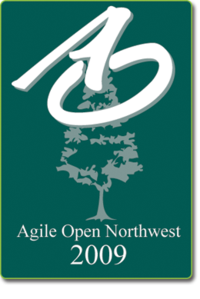 There was a moment, sitting in a session billed as "An Oral History of Agile," when Ward Cunningham mentioned that he had the idea to call the Agile Manifesto a manifesto because he'd read Cluetrain, and I realized suddenly both where I was and when I was: My God, I thought, I have shoes in my closet that are older than the Agile Manifesto! I'm here at the very beginning of something big.
There was a moment, sitting in a session billed as "An Oral History of Agile," when Ward Cunningham mentioned that he had the idea to call the Agile Manifesto a manifesto because he'd read Cluetrain, and I realized suddenly both where I was and when I was: My God, I thought, I have shoes in my closet that are older than the Agile Manifesto! I'm here at the very beginning of something big.
This was a terribly exciting revelation: Agile is so brand-spanking new that it's pretty easy to find yourself in a room full of people with first-hand knowledge of the very 'aha' moments that led to its inception. That who was there this week at Agile Open Northwest, people who have done a great deal of very original thinking on what amounts to the future of work.
Yes, I think that how we do software will be important beyond the realm of technology, because software is to this century what auto manufacturing was to the last: when Henry Ford invented the assembly line, he was inventing the human experience of production–how the individual relates to others, and to the process. These agilists may be doing just that for the next century. Only time will tell, and I am happy to be there to find out.
Here in no particular order are the highlights, for me, of the two days of sessions:
My first aha of the conference came during Jim Shore’s session on Agile Adoption Strategies. Jim said that, in his experience, gradual change doesn't in fact ease people in, it just burns them out on constant change and makes them unreceptive to the big insights. He elaborates on that idea, and on transition vs. transformation, here.
Jim also noted that it takes any team 3-4 iterations to achieve "familiarity" with agile processes, but that it matters not whether those iterations last 90 minutes or four weeks. This suggests to me that agile learning games and simulations are more valuable than I'd previously thought…
Speaking of which, Chris ran an agile games session (twice as it turned out), the crux of which was "the chair game," which pits teams against each other to solve a physical problem. After watching three teams spend twenty minutes trying to solve it and finally succeed, Jeremy Lightsmith observed, "It wasn't the great idea that solved the problem, it was the listening."
A comment all the more remarkable as the exercise was conducted in silence, evidence that listening takes place on more planes than the auditory.
In the last session of the conference, Chris pulled out one of his "greatest hits," a structured brainstorming exercise on "What Makes Agile Projects Succeed?" The number one factor: having a good agile coach. Number two: freedom to fail.
That was a recurring theme: that agile processes leverage failure well. It's clear that
one way agile leads to quality software is by allowing us to quickly
identify errors and convert them to learning, rather than
waiting until they are "problems" that cost us time and money. Llewellyn Falco showed us a skit using pennies, quarters and dice that neatly demonstrated something I am hereby dubbing the ROE, or Return on Error. Maybe that should be a new metric?
In the same vein, here's a quote I heard third hand during the conference closing, which sums up the Agile Failure Ethic nicely: "Broken gets fixed; shoddy is forever."
Another big aha for me revolved around my use of Twitter (#AONW). I tweeted my favorite quotes and insights throughout both days, and I found on reflection that even during sessions I deemed to be relative duds, I was gleaning insights, like "Done right, a 2 sentence user story is harder to write than a 40 page spec." That came right before I bailed on a session where I didn't think I was learning anything!
Twitter also enhanced the social potency of the conference. During a break, John Wilger approached me to talk about something I'd tweeted during a previous session, Ward's remark that 'Rails is a post-XP environment,' and we had a conversation about that. What a great way to capture extra goodness and be in places you aren't.
I'm looking forward to applying all of this learning to Agile Open California 2009 in October.
